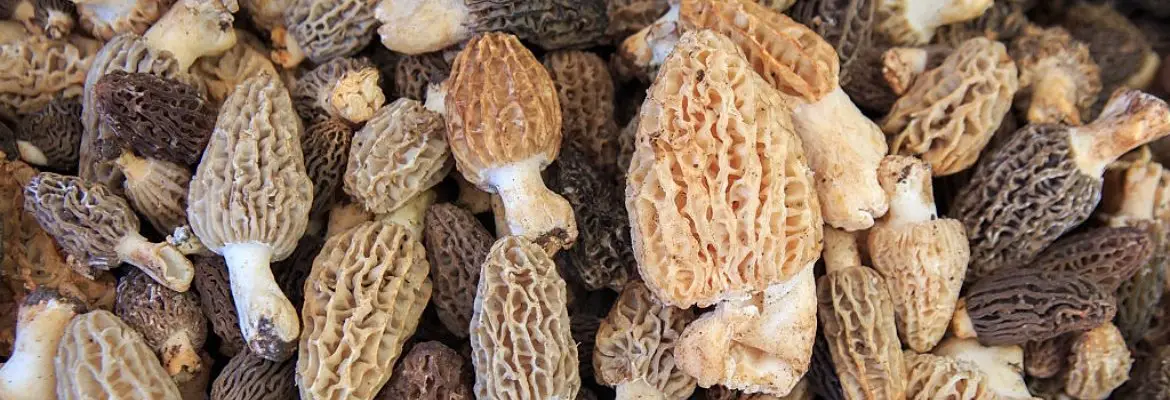Wild morel mushrooms are edible fruiting bodies formed by a fungus known as mycelium. The northern hemisphere is home to a diverse range of Morel mushroom species.
It grows in pastures, orchards, and meadows near spruce, ash, and elm trees and on disturbed terrain. Additionally, they are also found in burnt forests after a large wildfire in the spring.
Morel mushrooms have oblong, cone-shaped, bulbous, or egg-shaped caps attached to short, stout stems that range in size from small to large. The cap is usually between 2 and 7 centimeters in diameter and varies in color from blonde to light brown to dark brown.
Besides its fragile appearance, the brittle cap also has a hollow honeycomb-like exterior that is dotted with irregular holes and ridges and is attached directly to the stem. The mushroom’s cap and stem contain a hollow cavity that runs the length of the mushroom and the stem is white and is typically 2-9 centimeters long.

Since morel mushrooms can’t be cultivated because of their delicate growth conditions, as well as their short growing season, their prices have skyrocketed in the commercial market and they are hard to source.
The flavor of Morel mushrooms is deep, earthy, nutty, and woody when cooked.
For their unusual shape and flavor, Morel mushrooms are among the most prized culinary items. Their restricted availability also makes them a highly sought after delicacy.
Among the nutrients that morel mushrooms contain are fiber, iron, manganese, copper, phosphorus, zinc, vitamins D, E, K, and B. They are also a good source of potassium and calcium.
Scientific name of Morel Mushroom
Morchella esculenta
Other names of Morel Mushroom
- Guchi
- Yellow Morel
- Sponge Morel
- Molly Moocher
- Haystack
- Dryland fish
- True morel
- Common Morel
- Sponge mushroom
Calories by source in Morel Mushroom
- Calories by carbohydrate in Morel Mushroom = 58%
- Calories by fat in Morel Mushroom = 16%
- Calories by protein in Morel Mushroom = 27%
Fats and Fatty Acid profile of Morel Mushroom
- Polyunsaturated fat (PUFA) in Morel Mushroom = 79%
- Saturated fat (SFA) in Morel Mushroom = 12%
- Monounsaturated fat (MUFA) in Morel Mushroom = 9%
Nutrition facts of Morel Mushroom
*Serving size = 100 grams = 3.55 Ounces = 1/2 cup
*DV= % Daily Value (%DV indicates how much nutrients contribute to a person’s daily diet from a serving of a food. DV assists you in determining whether or not a serving of food is high or low in a particular nutrient.)
| Nutrient | Amount | Unit | DV |
|---|---|---|---|
| Calories | 31 | KCAL | |
| Fat | 0.57 | GRAM | 1% |
| Protein | 3.12 | GRAM | 6% |
| Carbohydrate | 5.1 | GRAM | 2% |
Detailed vitamin profile of Morel Mushroom, vitamin A, vitamin B12, vitamin B6, vitamin C, vitamin D, Folate, Niacin, Thiamin, and Riboflavin is shown in the chart.
Detailed mineral profile of Morel Mushroom, Sodium(Na), Calcium(Ca), Copper(Cu), Iron(Fe), Magnesium(Mg), Selenium(Se), Phosphorus(P), Potassium(K) and Zinc(Zn) is shown the chart.
Availability of Morel Mushroom
- Dried morel mushrooms are available round the year. Fresh morels mushrooms are available in spring season for a short period of time.
Complete nutrition facts of Morel Mushroom
Click on the link HERE to download high quality, high resolution and print ready PDF version of the Morel Mushroom nutrition chart/infographic.



